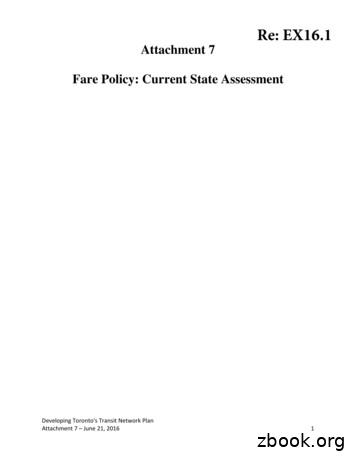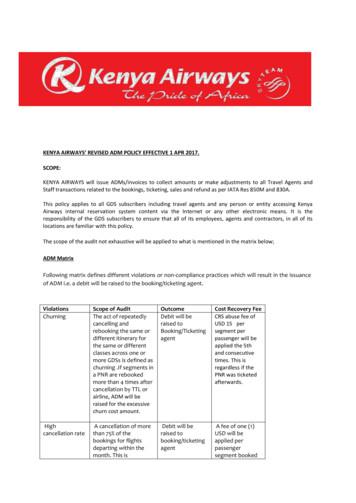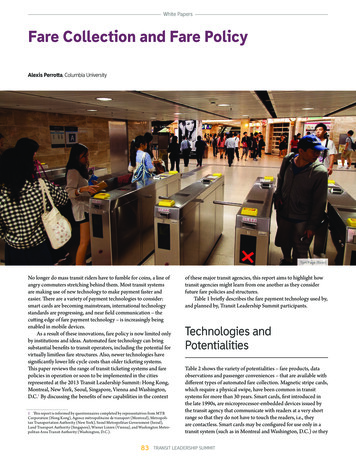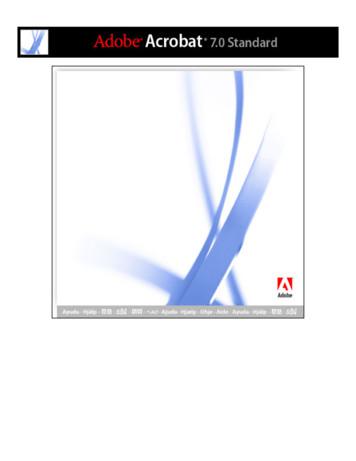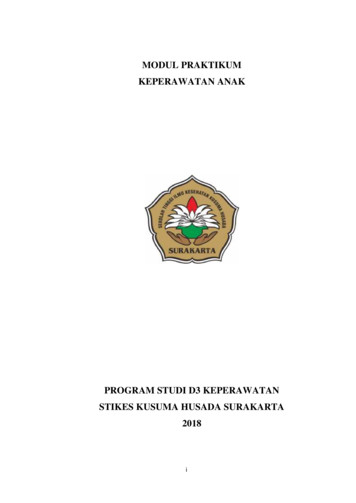Fare Policy: Current State Assessment - City Of Toronto
Attachment 7Re: EX16.1Fare Policy: Current State AssessmentDeveloping Toronto's Transit Network PlanAttachment 7 – June 21, 20161
Fare Policy Review - Current State AssessmentExecutive SummaryTransit fare policy needs to be considered in the context of ongoing initiatives being undertakenby the City, the TTC and Metrolinx. This report provides a current state assessment of transitfare policy in Toronto, focusing as a first step on issues related to the existing GO Transit farestructure.Metrolinx is working on a Greater Toronto and Hamilton Area (GTHA) Fare Integrationinitiative, which has a goal to develop a seamlessly integrated regional fare structure involvingall transit agencies operating in the region GTHA. The study is currently in Step 2 of a four-stepprocess, in which the City and TTC have been involved. Fare structures currently beingconsidered by the study include a modified 'status quo', zone-based fares and a hybrid farestructure (distance-based for higher-order transit and flat fares for local transit). These areillustrated in Figures 5 to 7.Fares on GO Transit provide an essential foundation for considering fare policy regionally. As afirst step, a focus on GO Transit fare policy issues offers the greatest potential near-term benefitsto Toronto. The evolution of GO Transit from a suburban-to-downtown commuter system to anurban Regional Express Rail (RER) connecting Mobility Hubs with frequent, all-day, two-wayservice will also require a fundamental evolution of the fare structure to achieve its goals.City and TTC staff have identified three key fare policy challenges that should be addressed onGO Transit: GO Transit's distance-based fare structure makes short trips substantially more expensive(on a per-kilometre basis) due to the relatively high base and low distance components ofthe fare. This creates a barrier to using GO Transit in Toronto, where trips are relativelyshort.There is currently no co-fare option for transfers between GO Transit and TTC services(which is available for transfers with 905 transit agencies); this requires riders to pay twofull fares when using both GO and TTC, reducing opportunities for riders to makeintegrated trips using both systems.GO Transit has stations within or in very close proximity to half of the City'sNeighbourhood Improvement Areas, most of which are not served by existing rapidtransit lines. Improving the affordability of GO Transit fares represents an opportunity toincrease rapid transit access for low-income residents.This report identifies some working principles that will guide City and TTC consideration of farepolicy issues and options, and inform discussions with Metrolinx. These principles include: Revenue – generate sufficient revenue to cover a portion of system operating costsEfficiency – distribute demand in a manner that makes the most efficient use of capacityFairness – provide consistent and logical prices for trips with similar characteristicsDeveloping Toronto's Transit Network PlanAttachment 7 – June 21, 20162
Social Equity – provide affordable access to transit for residents of all incomesCity-Building – align with the Official Plan vision and Provincial growth objectivesTransportation Outcomes – support transportation policy objectives (e.g. mode share)Deliverability – technical feasibility, and addresses operational/customer service needsAcceptability –must be implementable at an acceptable cost to the user and taxpayerThis report proposes a series of possible actions and next steps for Metrolinx consideration toaddress barriers to using GO Transit in Toronto, including: Reducing the base component and increasing the distance component of GO fares;Extending the co-fare option currently offered by 905 transit agencies to TTC services;andContinue working with the City and TTC to establish an appropriate fare for SmartTrack,consistent with the approach to pricing other transit services in Toronto.Some elements of the fare structure concepts being considered by Metrolinx in the GTHA FareIntegration review appear to conceptually address some of these considerations. Staff supportthe general direction that appears to show a reduction in the base fare for regional transit in eachconcept, and consistently applying the co-fare as shown in the modified 'status quo' concept. Theactual fare levels for the base and distance components and co-fares have not yet been addressed.The implementation of SmartTrack/GO-RER requires the resolution of fare structures, pricelevels and transfer policies between GO Transit and TTC services, particularly withinSmartTrack corridors. Fares on SmartTrack must be logically consistent with fares for othertransit services within the city, as well as fares within the corridor beyond SmartTrack stations,and have consideration for the principles outlined above.Metrolinx is anticipated to submit a technical update on the GTHA Fare Integration study at theirJune 28, 2016, board meeting. The City Manager in consultation with the CEO, TTC, will reportto Council as the Metrolinx study and assessment of the approach to SmartTrack fares progress.PurposeThis report focuses on the current state assessment of the GO Transit fare structure in Toronto, asit represents the most significant opportunity for immediate improvements to the regional transitfare system in Toronto and sets the context for the approach to SmartTrack/GO-RER fares.It sets out the current fare policy issues facing transit riders in Toronto, identifies some keychallenges that should be considered in the Metrolinx GTHA Fare Integration study, andsuggests a series of possible near-term actions and longer-term next steps to rectify issues thatrepresent barriers or disincentives to use GO Transit.The GO Transit fare system is designed to benefit long-distance commuters, which encouragesurban sprawl and limits its ability to be used for short and medium length urban trips, especiallywithin the City of Toronto. This report highlights a number of challenges identified by the Cityand TTC:Developing Toronto's Transit Network PlanAttachment 7 – June 21, 20163
GO Transit fares are high for short trips (on a per-kilometre basis), a situation thatdiscourages transit use in Toronto, who tend to make shorter and medium length trips.GO Transit fares are not affordable to low-income households, which limits access toeconomically vulnerable residents.TTC is the only transit that does not have a co-fare with GO Transit, making the cost oftransferring to GO service from the TTC at least 2 higher than in any other municipality.The introduction of GO-RER/SmartTrack offers the opportunity to leverage existing railinfrastructure and provide service with high frequency, speed, reliability and capacity in twodirections. The objective is to have GO-RER/SmartTrack meet a broader range of local andregional travel needs – from work, to shopping, recreation and social trips. Fare integration isessential to achieve this. 1The implementation of SmartTrack/GO-RER requires the resolution of fare structures, pricelevels and transfer policies between GO Transit and TTC, particularly within the SmartTrackcorridors. In adopting recommendations related to the SmartTrack work plan in January 2015and the Smart Track progress update in October 2015, City Council directed staff to work inpartnership with the Province on the implementation of SmartTrack/GO-RER, recognizing theneed for the integration of fares between GO Transit and the TTC.At the same time, Metrolinx is undertaking work on the GTHA Fare Integration initiative, whichis working toward developing a seamlessly integrated regional fare structure that would involveall transit agencies operating in the GTHA. The recommended preferred fare structure that willemerge from this work could represent a significant change to the fare structure in Toronto andmay have policy and financial implications that will need to be considered by City Council.The City Manager in consultation with the CEO, TTC will report to City Council on SmartTrackfares and the potential implications for the City of Toronto and TTC as the GTHA FareIntegration Study progresses.BackgroundThe Greater Toronto and Hamilton Area's 10 transit agencies each have standalone farestructures, some of which are not integrated, and each having different approaches to the pricingof services. With the introduction of PRESTO, Metrolinx and the GTHA's municipal transitagencies have the opportunity to move toward transit fare structures that are consistent andintegrated. Fare integration can help make the regional transit system more fair and efficient,while generating more ridership. The transit system in the GTHA is undergoing a majortransformation with new transit lines being built and delivered over the next decade. To get thegreatest benefit from this new infrastructure, fare integration needs to occur as that infrastructureis delivered.1Metrolinx (2015), GO RER Initial Business Case, Appendix J. ctevaluation/benefitscases/GO RER Initial Business Case Appendix A-J EN.pdfDeveloping Toronto's Transit Network PlanAttachment 7 – June 21, 20164
Regional fare integration is being undertaken in a multi-jurisdictional environment wheremunicipalities, their transit agencies and Metrolinx all have authorities for policy setting,implementation and management of their respective fare systems. This work is guided by thecurrent legislative framework for fare integration. The Metrolinx Act, 2006, establishesMetrolinx’s role as promoting and facilitating coordinated decision-making and investment inthe regional transportation area, including for routes, fares and schedules of the regional andlocal transit systems in the regional transportation area. It also provides authorities to implementthe PRESTO unified fare system. The City of Toronto Act, 2006, establishes the authority of theTTC to set fees and charges (i.e. fares), with the City authorizing the supporting subsidy throughapproval of the annual TTC operating budget.Evolution of GO TransitGO Transit, the regional public transit service for the Greater Toronto and Hamilton Area(GTHA), originated as a long-distance suburban-to-downtown commuter service. Conceived inthe 1960s when the population of Toronto was rapidly decentralizing to the suburbs, its originalpurpose was to reduce the need for highway construction into Toronto by providing a practicalalternative to automobile commuting to Downtown jobs.Figure 1 - Trips Destined to Union Station2The commuter rail experiment washighly successful, and GO Transit hasevolved from a single rail line runningalong Lake Ontario in 1967 to a networkof seven rail lines and 43 bus routestoday. GO Transit has experienced anincrease in commuters from 2.5 millionpassengers during its first year ofoperation to 69.5 million riders annuallyon the entire GO Transit network today.GO Transit's focus of service intoDowntown Toronto (specifically toUnion Station) continues to this day, asapproximately 94% of its train ridershiptravels to or from Union Station inDowntown Toronto (shown in Figure 1). 2Transportation Tomorrow Survey (2011)Developing Toronto's Transit Network PlanAttachment 7 – June 21, 20165
GO-RER: The Next Stage of EvolutionFigure 2 - Diagram explaining the evolution of GO Transit from a commuter system to an urban transit systemThe introduction of GO Regional Express Rail (GO-RER), by Metrolinx, will transform GOTransit to a viable urban transit service for all trip purposes. It will provide fast, frequent,reliable, two-way service with electric trains running every 15 minutes or better throughout theday. It is intended that every area on the most heavily travelled sections of the GO network willhave improved service and not be focused only on Union Station, as illustrated in Figure 2. 3Many GO stations have been identified as Mobility Hubs in the Regional Transportation Plan,which are planned to evolve into nodes with high levels of transit access with intensified transitsupportive land uses. The improved transit service on GO-RER must attract shorter-distancetrips and maintain long-distance commuters who travel across multiple municipal boundaries.SmartTrackThe City of Toronto is working in partnership with Metrolinx to introduce SmartTrack service,which is intended to be integrated into Metrolinx’s GO-RER service on portions of the Kitchenerand Stouffville/Lakeshore East corridors. SmartTrack will make GO-RER even more of anurban transit service as it introduces additional stations, closer station spacing, and higherfrequency service within the City of Toronto.The implementation of SmartTrack requires the resolution of fare structure and price levelsacross the GO Transit network within the City. The City's transportation model suggests thatridership performance on SmartTrack improves with fare levels consistent with a TTC fare, andfull fare and service integration with the remainder of the TTC network in the City. The farestructure implemented for SmartTrack must also consider the implications for fares on theremaining GO Transit network in the City, as well as the broader TTC network.3Metrolinx (2016), Regional Express Rail. er service.aspxDeveloping Toronto's Transit Network PlanAttachment 7 – June 21, 20166
GO Transit Fare StructureThe current fare structure used by GO Transit consists of base fare and zone-based distancecomponents. The base fare component is currently 5.30 ( 4.71 with a PRESTO fare card),representing the minimum fare riders must pay to access the system. The distance component iscalculated by fare zones, which are identified as discrete geographic areas across GO Transit'sservice area. Fare zones for Toronto are shown in Figure 3.Additionally, GO Transit offers co-fares for every local transit system in the GTHA with theexception of the TTC. GO Transit riders can transfer to or from local transit on journeys thatinclude a GO Transit component for a reduced local transit price when using the PRESTO farecard. Co-fares currently range from 0.50 to 0.80, depending on the local transit system.The GO Transit fare structure also provides concession fares for students, seniors, and children,which are available through all fare payment methods. Discounts for frequent users are providedexclusively through the PRESTO fare card. An 11.15% discount is provided for any trip paid forwith the PRESTO fare card, an 87.75% discount applies to trips 36 to 40 made between the samestations/stops per month, and a 100% discount applies to trips 41 in the same month.Figure 3 - GO Transit fare zone map for the City of Toronto. 44GO Transit (2016), Tariff, Passenger Rules and Regulations, Zones/Fares, Tariff of Fares, p. 25.http://www.gotransit.com/public/en/docs/Tariff EN.pdfDeveloping Toronto's Transit Network PlanAttachment 7 – June 21, 20167
Metrolinx GTHA Fare Integration StudyMetrolinx is undertaking a GTHA Fare Integration study, with the goal of integrating farestructures across all transit agencies operating in the Greater Toronto and Hamilton Area(GTHA), including GO Transit and the TTC, to create a seamless transit network. The studyresponds to commitments made in the Big Move Regional Transportation Plan (Strategy #6) 5and Metrolinx's 5-Year Strategy (Objective #3) 6 to deliver an integrated transit fare system forthe region. The City and TTC are involved in this process as consulted stakeholders.The Metrolinx evaluation criteria for the study are organized around the objectives of simplicity,value, and consistency. These categories encompass criteria from several perspectives such ascustomer, service provider, and regional perspectives. The criteria are heavily focused aroundcustomer service, operational, and financial considerations. The fare structure options currentlybeing considered in the study are illustrated in greater detail in Figures 5-7 on the followingpage.Metrolinx (2008), The Big Move (Regional Transportation Plan), pp. 42-43.http://www.metrolinx.com/thebigmove/Docs/big move/TheBigMove 020109.pdf6Metrolinx (2015), 2015-2020 Metrolinx 5-Year Strategy, p. s/Metrolinx Five Year Strategy 2015-2020 EN.pdf5Developing Toronto's Transit Network PlanAttachment 7 – June 21, 20168
METROLINX'S PROPOSED FARE STRUCTURE CONCEPTS 7Figure 5 - Concept 1:Figure 6 - Concept 2:Modified Status QuoLocal and Rapid Transit ZonesFigure 4 - Existing Fare Structure:Status Quo Lower base fare on short Lower base fare for short and Lower base fare on short-mediumregional tripsmedium regional tripsregional trips Moderate distance-based fare Higher distance-based fare on Regional-wide flat local farefor medium regional tripslong distance trips Rapid local transit comparable tolocal for short trips Higher distance-based fare for Very low short local and rapidlong regional tripslocal transit fare Moderate distance-based fare onrapid local transit and regional Lower flat fare on local and Low medium local and rapidrapid local transitlocal transit faretransit for medium trips Consistent transfer policy (co- Medium local and rapid local Higher distance-based fares onfare) between all municipaltransit fare for longer tripsregional and rapid local transit fortransit and GOlong tripsCITY OF TORONTO / TTC SUPPORTED FARE STRUCTURE CONCEPTS BY METROLINXHigh flat fare on regionaltransit for short and mediumtrips; distance-based long tripsLower flat fare on local andrapid local transitRange of co-fares betweenregional and 905 operatorsNo co-fare between regionaland Toronto operator 7Figure 7 - Concept 3:HybridLower base fare on regional tripsLower fare on short and medium regional tripsNo price differentiation between local bus and rapid transit tripsConsistent transfer policy between municipal transit and GOMetrolinx (2016). GTHA Fare Integration (presentation for Toronto Municipal Update), May 26, 2016.Developing Toronto's Transit Network PlanAttachment 7 – June 21, 20169
City-TTC CommentsCity and TTC staff support certain elements of the general direction presented in the Metrolinxfare structure concepts. Each concept shows a reduction in the base fare for regional transit,which is consistent with the direction this report suggests that Metrolinx consider. Actual farelevels for the base and distance components are not addressed in these concepts and need to bethe subject of further analysis and discussion.In Figure 4, Metrolinx has characterized the current 'status quo' fare structure. This diagramreflects the fare structure from the perspective of Union Station. A more generic characterizationof the fare structure is diagrammed in Figure 8, reflecting fares for transit trips that could startand end anywhere in the region, and accurately shows GO Transit's distance-based faresapplying to short and medium length trips.Figure 5 shows the co-fare being made consistent across the region, with the price level again notdefined. Concepts that introduce additional service-based elements into the structure (such asFigure 7) raise concerns, such as divergence between local surface and rapid transit, due theevolution of the TTC into a highly integrated system.Figure 8 – Generic depiction of current regional fare structure.In the past year, Metrolinx also conducted a comprehensive and in-depth social equity analysisof transportation in the GTHA. This analysis will be used to inform the GTHA Fare Integrationstudy and the evaluation criteria for the study have been adapted to include insights from thesocial equity analysis.Metrolinx is anticipated to submit a technical update on the fare integration study at their June28, 2016, board meeting. The recommended fare structure concept from Step 2 is anticipated tobe submitted to a future Metrolinx board meeting for consideration following furtherconsultation with municipalities and transit agencies across the GTHA.The current fare structure of GO Transit is inconsistent with a number of key local and provincialpolicies, especially in the areas of growth management, city-building, social equity, transitridership and related policies (see the appendix to this paper). There are several reasons for this:10
The fare structure is not integrated with local systems (especially in Toronto where no cofares is available), and fare levels are inconsistent with those charged by local agencies.The high base fare discourages shorter trips and compact development, and the lowdistance-based component encourages longer trips and urban sprawl.The lack of financial incentives to use GO Transit does not encourage alternative modesof transportation as a policy imperative, contributing to greater greenhouse gas emissionsby private vehicles.Equity and AccessGO Transit Distance-Based Fare StructureFigure 9 - Fare per kilometre for trips to/from Union Station on GO Transit (based on June 2016 prices), showing trips starting orending in Toronto being up to 8x more expensive per kilometre than trips between Union Station and 905 GO stations.GO Transit's distance-based fare structure makes typical trips within Toronto substantially moreexpensive, creating significant barriers to the use of the system in Toronto.Reflecting the original purpose of the system, the fare structure has been designed to attract longdistance commuter trips and discourage short-distance trips. In order to encourage GTHAresidents outside of Toronto to choose GO Transit, transit fares have been maintained atrelatively low rates for longer-distance trips.Residents of Toronto making short trips on GO Transit are charged significantly higher fares ona per-kilometre basis than regional residents who make longer trips to Toronto. Figure 9 showshow the per-kilometre fare for trips on GO Rail to/from Union Station decreases as the distanceof the trip increases. The implications of this relationship can be illustrated by comparing faresfor shorter and longer trips on the same line.11
On the Lakeshore West line, for example, the fare to Union Station from Hamilton (a trip of 65km) is currently 11.50, or 0.18 per kilometre. In comparison, the fare to Union Station fromExhibition (a trip of 3 km) is currently 5.30, or 1.67 per kilometre. Fares to Union Stationfrom stations between Hamilton and Exhibition fall in between these extremes, but areconsistently more expensive (on a per kilometre basis) for trips originating in Toronto than tripsoriginating in 905 municipalities.This situation is not unique for trips beginning or ending at Union Station. The example of faresfor trips to/from Kipling Station (shown in Figure 10), a station in Toronto with relatively highridership, is indicative of per-kilometre fares charged for short and long trips from the typicalGO station. While a longer-distance trip between Kipling and Milton Stations costs about 0.30per kilometre, a shorter-distance trip between Kipling Station and the adjacent Dixie Stationcosts almost 1.20 per kilometre, or four times as much.Figure 10 - Fare per kilometre for trips to/from Kipling Station on GO Transit (based on June 2016 prices), illustrating therelationship that short trips are significantly more expensive on a per-kilometre basis.The relatively high base fare component and lower distance-based component makes short tripsmore expensive on GO Transit. On average, Toronto residents make shorter trips by all modesthan 905 residents (8.0 km vs. 11.5 km) 8. Toronto's higher population and employment density,mixed land use patterns, neighbourhood jobs-housing balance, and grid street network designtend to bring people closer to jobs and other destinations, all contribute to reducing the need totravel longer distances. The difference in average trip lengths is even greater for transit trips, at8.7 km for Toronto residents and 19.6 km for 905 residents 9. For trips made on GO Transit,89Transportation Tomorrow Survey, 2011. Figures represent straight-line distance.Transportation Tomorrow Survey, 2011. Figures represent straight-line distance.12
Toronto residents travel an average 23 km compared to 36 km for 905 residents 10. This is partlybecause GO stations in Toronto are closer in proximity to Union Station, the hub of the GOTransit network (where 94% of GO trips begin or end).Because Toronto residents make shorter trips, the relatively high base fare is distributed overfewer kilometres, and becomes a much larger component of the fare than trips to/from suburbanstations. This reduces the value proposition of the GO fare for Toronto-based trips, an effect thatis accentuated for the shortest trips between adjacent stations, such as the trip between Union andExhibition stations. The price structure discourages Toronto-based trips from using GO Transit,even when the GO network may be the most efficient or logical choice when viewed from atransportation operator's efficiency perspective or user's travel time perspective. As shown inFigure 11, only 12% of GO Transit riders live in Toronto while 88% are residents in the GTHAoutside of Toronto. 11Figure 11 - GO Transit trips by area of residence, illustrating that only12% of GO Transit riders live in the City of Toronto while 88% live in905 municipalities.Metrolinx has recently acknowledged theissues a high base fare creates for shortdistance trips, and at Metrolinx'sFebruary 2016 board meeting, a numberof options were presented forconsideration. Three fare structureoptions were presented with diagramsshowing a reduction in the base fare forregional trips (see Figures 5-7).Metrolinx has also taken someincremental but concrete steps towardcorrecting the problem. During theconsideration of recent GO Transit fareincreases taking effect February 2016,the Metrolinx board approved a tieredapproach to fare increases where fares forshort trips were frozen at 2015 levels.This effectively froze fares from UnionStation to 75% of GO stations withinToronto.Metrolinx should consider further steps to make GO Transit's fare structure more equitable andmore viable for shorter trips by reducing the base fare component, consistent with the directionof the concepts at the February 2016 meeting, and increasing the distance-based component ofthe fare, as illustrated in Figure 12. In addition, the distance-based component could moreaccurately and consistently reflect the actual distance travelled than the coarse granularityprovided by the current fare zones shown in Figure 3. The optimization of the actual price levelcharged for the base fare and distance increment could be analyzed further as part of the City/TTC contribution to the Metrolinx GTHA Fare Integration work. This analysis should considerthe various principles and evaluation criteria set out in this report with an emphasis on ridership,city-building, revenue, equity, efficiency and other factors.1011Transportation Tomorrow Survey, 2011. Figures represent actual trip distance.Transportation Tomorrow Survey (2011).13
Figure 12 - Left: Illustration of current fare structure. Right: Reducing base fare and increasing distance fare on GO Transit.Implications for "905" Transit RidersAddressing the fare structure challenge for short and medium trips can have future benefitsacross the GO Transit network. Although the majority of GO Transit trips made by 905 residentstoday are focused on travel to Union Station, short trips to adjacent or nearby stations on GOTransit are also relatively expensive in municipalities outside of Toronto. As development andintensification occur around GO station Mobility Hubs in the 905 and these stations need tobecome a destination point for ridership, the same fare policy issues facing Toronto residentstravelling to Union Station will become apparent for short trips to suburban GO stations.Figure 13 – Fare per kilometre for trips to/from Oakville Station on GO Transit (based on June 2016 prices), illustrating the higherper-kilometre cost of shorter trips and lower per-kilometre cost of longer trips.Oakville Station is a representative example. It currently attracts among the highest ridership ofall GO Transit stations, has been designated a Mobility Hub by the Regional Transportation Plan.14
"Midtown Oakville" has been the subject of significant transit-oriented intensification planningsponsored by Metrolinx, the success of which will rely in large part to the ability of commutersto access the development via the GO Transit network.Figure 13 plots the per-kilometre fare for trips to/from Oakville Station against the trip distanceto/from Oakville Station. As with the pattern observed for Union Station, trips to/from adjacentstations are significantly more expensive on a per-kilometre basis than trips to/from more distantstations. The fare to Oakville from Union Station (a trip of 34 km) is 8.65, which works out toabout 0.25 per kilometre. In contrast, the fare to Oakville from Bronte, the adjacent station tothe west (a trip of 5.5 km) is 5.30, or almost 1 per kilometre.These examples demonstrate how GO Transit's fare structure is inconsistent with the long-termobjectives for the nodal transit-oriented development that GO-RER is intended to catalyze alongGO Rail lines. The high base fare and low distance-based component makes short trips on GOTransit expensive, discouraging its use for that purpose.Affordability of GO Transit fares for low-income residentsFares on GO Transit are prohibitively expensive for low-income residents and GO Transit doesnot currently provide concession fares for low-income transit riders. Most transit agencies,including GO Transit and TTC, offer untargeted discounts to address social equity, primarilyconcession fares for seniors, children and students.Recognizing that a fast-growing number of low-income Torontonians have unmet transit needs,the Toronto Poverty Reduction Strategy and the Toronto Strong Neighborhoo
Fare Policy: Current State Assessment . Developing Toronto's Transit Network Plan Attachment 7 - June 21, 2016 1 . Re: EX16.1. Fare Policy Review - Current State Assessment . . focusing as a first step on issues related to the existing GO Transit fare structure. Metrolinx is working on a Greater Toronto and Hamilton Area (GTHA) Fare .
Fare difference between fare purchased and the fare where actual travel commences. Fare/sales violation Validation on the compliance of fare and sales conditions on all purchased tickets (e.g. advance purchase, agency applicability, add-on fares, blackout period, booking class, under collection of
2. A Business Circle Asia fare may be upgraded to a higher tiered Circle Asia fare or a First Class Circle Asia fare without fee. 3. A First Circle Asia fare may be upgraded to a higher tiered Circle Asia fare without fee. 4. Upgrading by sector to Business/First Class is not permitted. 5. At any time the
White Papers Benefits of Advanced Fare Technology Advanced fare technology offers a wide range of benefits. For passengers these include convenience, and for the operators better ways of managing demand and/or addressing equity concerns through differentiated fares, co
1. Scegliere Modifica Preferenze (Windows ) o Acrobat Preferenze (Mac OS), quindi fare clic su Generale a sinistra. 2. Selezionare Usa singoli tasti di scelta rapida per accedere agli strumenti. 3. Fare clic su OK per applicare la modifica. Per aprire la finestra Come fare per: Premere Maiusc F4. Per chiudere la finestra Come fare per:
Pricing - Bus Single Ride 24 Cash Fare City Adult Student S/D/M Oklahoma City 1.75 0.75 0.75 Albuquerque 1.00 0.35 0.35 Colorado Spring 1.75 0.85 0.85 Des Moines 1.75 0.75 0.75 Fort Worth 1.75 0.85 0.85 Kansas City 1.50 0.75 0.75 Little Rock 1.35 0.60 0.65 Madison Count
OCTA (Orange County) These agencies represent a range of types of l:are policies and structures, and are at various . falls well below the peer average of 0.89. However, the MTA’s distribution of revenues by fare category (see accompanying graph) is reasonably consistent . peer average bus fare ( 1.32) and somewhat higher than the peer .
Denny’s Fit Fare is your guide to better nutrition. You can choose from our FIT FARE OPTIONS and substitute healthier items like egg whites, chicken sausage, hearty wheat pancakes and sugar-free syrup. Also consider our Fit Fare meals; you’ll find them throughout the menu. Just
Buku ini tersusun berkat kerjasama tim pengajar mata kuliah Keperawatan Anak, oleh karena itu penulis mengucapkan terima kasih kepada pihak yang turut membantu penyelesaian buku ini. Semoga buku ini dapat bermanfaat. Saran dan kritik untuk perbaikan buku ini kami harapkan. Terima kasih. Tim Penyusun
